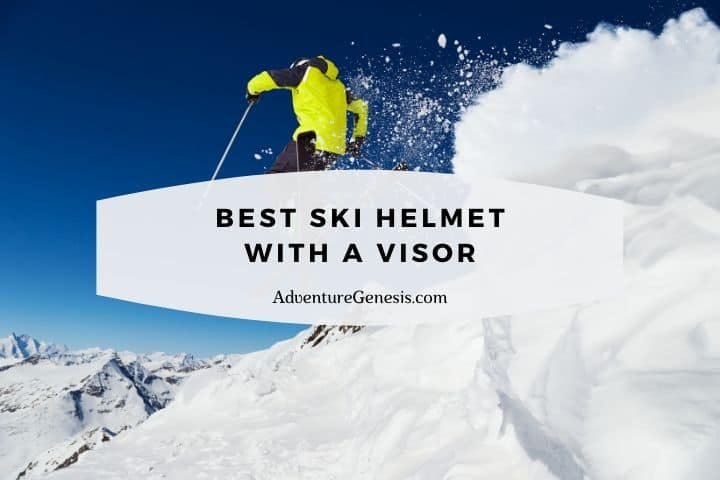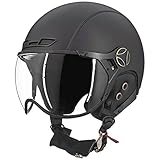What is the best ski helmet with a visor? I’ve found that the MOON Ski Helmet shows the greatest care for customers’ safety, comfort, and performance, and it is overall the best ski helmet with a visor.
Table could not be displayed.These days, it’s pretty widely accepted that everyone should ski with a helmet, but sometimes it can be frustrating coordinating your helmet and goggles to fit well together. There’s nothing worse than ending up with a “gaper gap” between the two, with cold air blasting your forehead and all your ski swagger out the door.
One of the best solutions to this problem, and to the issue of finding goggles that fit over glasses, is to simply buy a helmet with a built-in goggle visor.
With these helmets ranging hugely in price and performance, it’s a good idea to know what is on the market. Here’s my list of the top three best ski helmets with a visor.
Reviews of the Best Ski Helmets with a Visor
1. MOON Ski Helmet
No products found.
The MOON Snow Ski Helmet with a visor comes in a few different colors and styles, which is a nice change of pace from the more basic VOKUL model.
A lot of the technical specifications are the same, including the fact that the visor and the earpads can be removed, which topped my list of important features.
Unfortunately, it doesn’t seem like the company sells additional or replacement lenses, so the visor would only be removed in order to replace it with goggles. Luckily, the lens appears to be a nice orange color, which I would guess has a very accommodating VLT and would perform well in most conditions. Customers attest that this helmet provided great visibility.
This helmet also has a very adjustable fit, with the same dial at the back of the helmet to either tighten or expand the helmet’s grip. There are also vents on the top and the back of the helmet, which can be opened or closed, depending on the desired temperature.
Finally, this helmet meets safety standards with its CE EN 1077 certification.
Pros:
- Removable lens and ear pads
- Orange lens
- Great ventilation
Cons:
- No warranty
- No replacement/alternate lenses
No products found.
2. VOKUL Unisex Snow Ski Sport Helmet
No products found.
One thing that really stood out to me about VOKUL’s product description for this unisex snow ski sport helmet is that they take safety seriously. While it’s common to see safety standards shrugged off as implicit, VOKUL makes a point to elaborate on the ABS shell and soft EPS liner, which combine comfort and protection to give you a safe but enjoyable ride.
They also are one of the very few helmets to attest to the fact that they’ve met both the American and European impact test certifications (ASTM and CE) and been approved by the United States Consumer Product Safety Commission (CPSC).
VOKUL’s helmet with a visor offers an adjustable fit, from the chin strap to the small knob on the back of the head, which can tighten or loosen the helmet’s frame.
The liner and plush ear cushions are also removable, so it’s easy to cool off on a hotter day or to run the liner and cushions through the wash when they get good and stinky.
Another plus for a hot day is that this helmet has top vents that easily open and close. The visor itself can also be removed, which is helpful if you end up needing separate goggles for any reason.
Finally, the product has an 18-month warranty, which is really hard to beat.
Pros:
- Most affordable
- Removable visor and earpads
- Good ventilation
- Safety first
Cons:
- The lens is not colored (dark grey)
- Unisex style is pretty bland
- Only one type of lens available
No products found.
3. NENKI Ski Helmet
No products found.
The NENKI Ski Helmet delivers everything you’d need from a good helmet with a visor: it’s CE certified to be sufficiently impact resistant, and its lens is 100% UV Excluded and has an anti-fog coating.
These are just the basics, though, and there isn’t much more that this helmet offers. Even the style is a bit bland, offering only either a plain black or a plain white helmet.
The best thing that this product offers is additional lenses for sale, separate from the helmet itself. This includes an iridium red, iridium silver, or iridium yellow lens.
Unfortunately, there’s no information on the VLT (visible light transmission) that each of these lenses offers, though I would assume that the red is the most well-rounded lens, while the yellow would be best for low light and the silver best for high light. Each lens is about half the price of the helmet itself.
The big drawback with this helmet is that there are no air vents, and the earpads can’t be removed, which both can make for a pretty hot and uncomfortable ride. Plus, if your head gets too hot, it’s a lot more likely that the goggle lens, or potentially the glasses underneath, will fog up.
Finally, though it’s only by half a pound, this is the heaviest of the helmets on my list. There also doesn’t appear to be any warranty included with this product.
Pros:
- Additional lenses available
- CE certified
- Cheapest option from the list
- Available for men, women, and youth
Cons:
- No air vents
- Earpads can’t be removed
- No warranty
- A bit heavier than competitors
No products found.
How to Choose the Best Helmet with a Visor for Skiing – Buyer’s Guide
A helmet is a very important safety feature to any skier’s setup, but if you want to go above and beyond just protecting your noggin, getting a helmet with a visor is a great way to comfortably fit glasses under your goggles, or just to avoid to “gaper gap” at all costs.
Here are some of the best features of these helmets and different elements to consider as you shop.
Lens
Dual lenses with anti-fog and anti-scratch coating are ideal for improving visibility and keeping the product in its best condition. This common feature of goggles has been integrated into the helmets I’ve chosen to include on this list.
The next best way to make sure you don’t get a bunch of fog is to have a balance between a good fit that doesn’t let too much air in, but also a ventilation system that lets any air out that does manage to get trapped.
It’s also important to think about the color of the lens and what its VLT might be.
The helmet/visor combos that I’ve listed here don’t provide an actual percent VLT for their visors, which is a little annoying, but based on reviews and the general shade of each of the lenses, I’d say they’re designed for everyday use and have a VLT anywhere between 10-30%.
This is a safe bet for anything from light cloud cover to a pretty sunny day, but it’s worth considering whether the manufacturer sells alternate lens colors to provide a range of options.
Ventilation
Nobody wants a helmet that feels stuffy and too hot. Plus, it’s important that a little air moves through the goggle lens to keep them clear.
Most goggles have a top and bottom vent built into a foam frame, and these helmets pretty much have the same setup purely as a result of the helmet’s design.
Since the visor is on a hinge, it sits just a little bit off the helmet and leaves room for air to get in through the bottom and out through the top.
The drawback of this design is that the breeze will be freer flowing than it would be with traditional goggles, which could make it a little cold depending on your preference.
Some customers suggested that a foam lining would make the setup warmer, while others said that the breeze kept their lenses, and potentially their prescription glasses sitting underneath, totally clear from fog.
Whether it’s worth the trade-up is ultimately up to you, but the most common praise for these helmets is the ease with which you can slide the goggle lens up and down.
Impact Resistance
Overall, the most important thing to know about any helmet is whether it meets the standard safety certification. The label of CE EN 1077 certification is the European standard and means that the helmet has been tested for impact resistance and is authorized for non-motorized snow sports.
There are some different qualifications internationally, like ASTM F2040 in the US, but they ultimately mean the same thing when it comes to safety and it’s not unusual to only see the European standard listed.
Comfort
Finally, make sure you buy a helmet that will fit you well. There are small differences in the fit of each of these helmets that you can discern a bit more by reading through customer reviews and checking out the dimensions.
If you use a tape measure, starting at the center of your forehead just on your hairline, and wrap it under the bulge at the back of your head and back to the front, you’ll have a good measure of your head circumference and can choose your helmet size from there. Make sure to measure in centimeters!
My Choice for the Best Ski Helmet with a Visor
If you struggle to fit goggles over your prescription glasses or are just looking for a good way to avoid the “gaper gap” and protect your face from the wind while skiing, I believe that the best ski helmet with a visor is the MOON Ski Helmet.
VOKUL’s product has a flexible fit and prioritizes safety. The helmet’s inner liner, ear pads, and visor are removable, and the product comes with an 18-month warranty to make sure you’re happy with it.
NENKI sells three different colored lenses that can be interchanged on their ski helmet. Both are great, affordable alternatives, while guaranteeing the same degree of safety and performance.
Top Rated Ski Helmets with a Visor
Last update on 2025-10-05 / Affiliate links / Images from Amazon Product Advertising API




